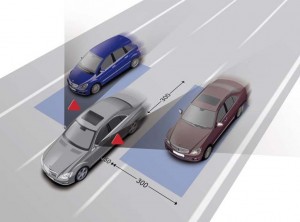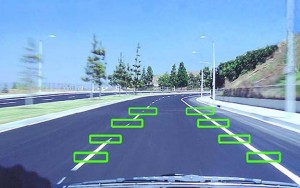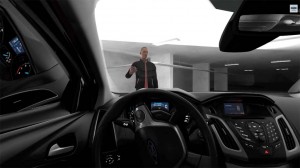New, high-tech driver assistance systems like Lane Departure Warning and Blind Spot Detection, or LDW and BLIS, are helping sharply reduce the number of crashes on U.S. roadways, in the process curbing injuries and reducing deaths.
Those and other technologies, including forward collision warning and automatic emergency braking, are becoming increasingly common on today’s new vehicles and two new studies by the Insurance Institute for Highway Safety suggest they may have been a factor in the recent decline in U.S. automotive fatalities.
Some safety experts believe that what are collectively known as Advanced Driver Assistance Systems, or ADAS, are critical in offsetting an epidemic of distracted driving crashes, though there are also concerns that motorists might come to rely too heavily on the technologies and not be as vigilant as possible.
(U.S. highway fatalities dip 1% during first half of 2017. Click Here for the full story.)
The first of the new studies by the IIHS, an insurance industry-funded safety research group, looked at the effectiveness of Lane Departure Warnings systems. LDW typical relies on one or more cameras to scan the road ahead to make sure a vehicle is staying safely within the lane markers. If a vehicle drifts out of the lane – which can happen when someone is tired, intoxicated or distracted – the system issues an alert. That can be a buzzer, a flashing light or even a buzz within the driver’s seat.
According to the IIHS research, LDW reduces the number of single-vehicle, sideswipe and head-on crashes by 11% overall, and injury crashes by 21%. By the IIHS’s calculations that would have prevented 85,000 police-reported crashes in 2015 and eliminated 55,000 injuries. The fatal crash rate for those types of accidents was reduced by 86%, according to the study.

Blind spot systems, such as the Mercedes-Benz technology diagrammed here, have become increasingly common on new vehicles.
“This is the first evidence that lane departure warning is working to prevent crashes of passenger vehicles on U.S. roads,” said Jessica Cicchino, the IIHS vice president of research. “Given the large number of fatal crashes that involve unintentional lane departures, technology aimed at preventing them has the potential to save a lot of lives.”
(Click Here to see why you and everyone else in the car is at risk when rear passengers aren’t using seatbelts.)
Other studies appear to support that research. A 2015 study of LDW systems used on trucks found that the rate of those three types of crashes – which typically involve at least one vehicle leaving its lane – was cut by nearly half. A study in Sweden by Volvo Cars found a 53% reduction in those crashes.
If anything, the new IIHS study says LDW technology isn’t proving as effective as possible because many motorists turn the systems off – a process usually involving just the touch of a button – to avoid hearing the buzzes and beeps when they inadvertently cross a lane marker. Several automakers have told TheDetroitBureau.com that they are working on ways to make the warnings less objectionable while still immediately apparent to motorists.
Another reason why the technology might not work to its maximum benefit is the fact that of 631 drivers involved in lane-drift crashes studied by the IIHS 34% were physically incapacitated and failed to respond to the warnings.
Newer systems, such as the Blind Spot Detection with Steering Assist and Run-Off Road Mitigation found on the completely redesigned 2018 Volvo XC60, can help in such situations by actually nudging the vehicle back into its lane, in some cases without any steering input from the driver.
Blind Spot Detection has also proven effective at preventing crashes, according to the IIHS, alerting drivers to vehicles alongside that they might have missed when changing lanes. The second study found a 14% reduction in crashes and a 23% reduction in injuries of all severities.
“If every passenger vehicle on the road were equipped with blind spot detection as effective as the systems we studied, about 50,000 police reported crashes a year could be prevented,” said Cicchino.
The good news is that these and other ADAS technologies are becoming increasingly available in the latest generation of vehicles, and consumer “take rates” are increasing rapidly, as well.
In years past, technologies like BLIS and LDW were offered first on luxury vehicles and often costs hundreds, even more than $1,000 apiece. Today, many mainstream manufacturers, such as Chevrolet, Ford, Nissan and Toyota, are bundling these systems together and offering them as relatively low-cost packages. More manufacturers are incorporating such technologies as standard equipment each year. The 2018 Chevy Traverse, for example, comes with blind-spot warning, rear-cross traffic alert, forward collision warning with pedestrian detection and lane-keep assist on all grades, including base models.
(Proposed Hot Car bill aims to prevent heatstroke when children are left in hot vehicles. Click Here for the story.)
ADAS systems are seen as the foundational technology for the coming era of fully autonomous vehicles, but for now, “Drivers must still retain control of their vehicles and simply use these features as assistants,” Malin Eckholm, the head of safety development at Volvo, told TheDetroitBureau.com.
Two decades ago, as some of the earliest computer-controlled safety systems moved into the vehicle there were concerns they actually could backfire. Motorists used to pumping a vehicle’s brakes in a skid often weren’t used to the way then-new ABS technology worked – requiring the driver to press down hard on the brake pedal – and there was actually a slight spike in crashes on vehicles equipped with such systems.
A third new study, this one conducted by the insurance industry-funded AgeLab, run by the Massachusetts Institute of Technology, found that motorists using new automated parking systems often fail to look around them – staring instead at the vehicle’s videoscreen – when such technology is being used.
But research released several years ago by the IIHS suggested that motorists are becoming more aware of how such technologies work and are responding more appropriately. And some systems, such as Electronic Stability Control don’t necessarily need the driver to intervene. That study found a big reduction in crashes as a result of ESP. The IIHS has also found measurable crash reduction benefits from Forward Collision Warning technology, especially if the vehicle also is capable of automatically applying the brakes in an emergency should the driver not respond to warnings.



That is incorrect about the 2018 Traverse. Only the LT Leather and up have Rear Park Assist, Side Blind Zone Alert and Rear Cross Traffic Alert. The Premier also has an optional package of Forward Collision Alert, Lane Keep Assist, Front Pedestrian Detection, and Low Speed Forward Automatic Braking. The High Country is the only Trim that has all safety features included in the base price.